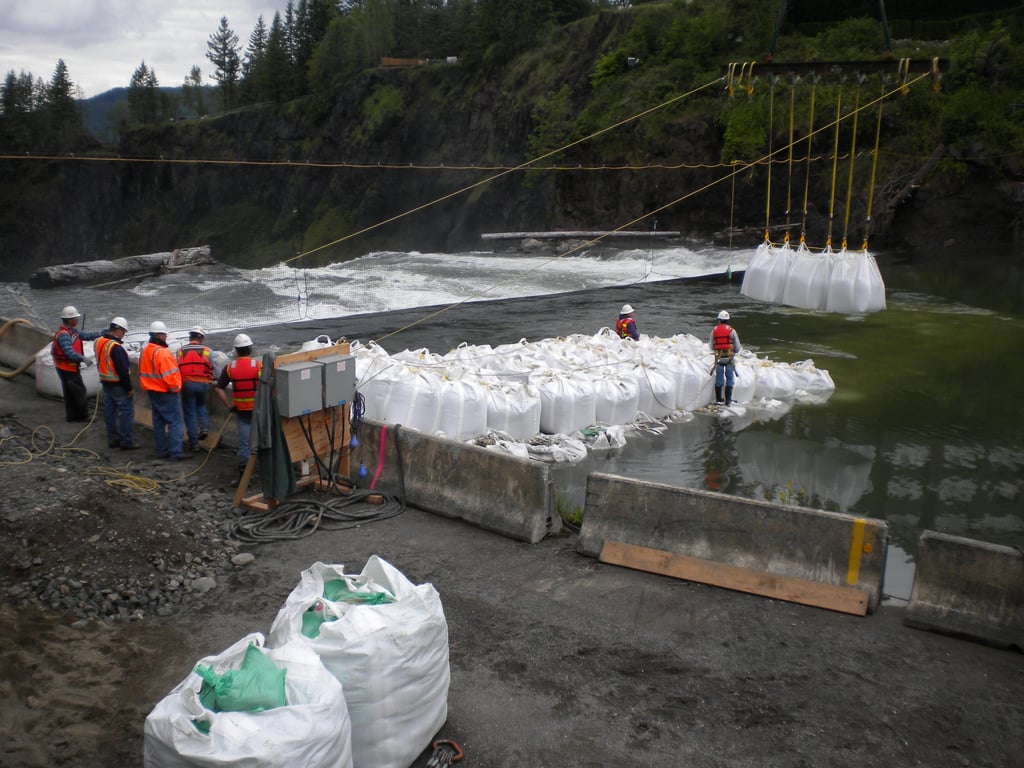 Friday, July 26, 2024
Friday, July 26, 2024  Friday, July 26, 2024
Friday, July 26, 2024 There are many uses for the tried and true bulk bag. As a bulk packaging company, we have supplied ‘MiniBulk Tough’bags to a myriad of industries. You might have heard our catch phrase “From Alfalfa to Zinc!” For the average person who does not use bulk bags or poly woven bags, this claim might seem a little grandiose. Regardless, the applications are limitless, and I would like to highlight some of the niche projects that we have been involved with over the years. Today, we are going to talk about cofferdams.

Snoqualmie Falls Power House Redevelopment Project. Construction by Barnard Construction 2009 to 2012. Bulk Bag Cofferdam designed by PND Engineers as part of Weir Demolition above Snoqualmie Falls.
A cofferdam is simply a temporary dam built to hold back water so equipment and people can work in a dry environment. The construction industry is especially involved with the building of cofferdams in projects that intersect a body of water, or in areas where they need to protect aquatic life during building. Repairing bridges, building support columns, and even ship building are projects that may require a cofferdam.
They can be made using materials like steel sheeting, concrete slabs, or any other heavy material that can withstand the forces of hydrostatic pressure for an extended period of time. However, these methods can become very expensive depending on the size and scope of the project. In some cases, making a cofferdam out of bulk bags is faster, less costly, and easier than other methods. Since the weight of the material in the bags is enough to stop water, there is no need for bracing, wales, or other reinforcement methods. And at the end of the project, a bulk bag cofferdam can be taken down as fast as it was installed.
My first introduction to cofferdams was about 5 years ago. If you remember when CrossIron Mills opened up in Balzac, you remember the traffic Armageddon that was unleashed on the QE2 that day! In what can be only described as a major oversite, the developers assumed having only one exit onto the major highway was enough to handle southbound traffic. While secondary highway 566 is a decent road, the overpass at Balzac was never designed to handle the volume of traffic created by this new shopping destination. With 250,000 people visiting in the first five days, it was clear another exit was required to keep people safe and happy!
Plans were drawn up to build another overpass on the south side of the complex that connected with CrossIron Drive. At the time, CrossIron Drive was only a one-way, north-bound route that allowed thousands of Calgarians into the complex, but not out. As mentioned earlier, this was a huge problem for shoppers trying to exit, as the only way back to the QE2 was to head north, connect with 566, and sit and wait on that poor overpass!
The new overpass plans were drawn up, and a construction firm was contracted to do the work. However, there was one major problem they needed to address before construction began. The plans called for the new ramp to run alongside protected wetlands west of the highway. They could build the ramp, but they needed to protect the wildlife life during construction. The solution? A cofferdam built with MiniBulk bulk bags!
For this cofferdam project, we supplied them with our 215E stock bag, the bag with the heaviest weight capacity we carry. This particular bag has a safe working load of 1850 kgs, or 4,070 lbs PER bag. In addition to the bags, we supplied them with 4 mil polyethylene liners that went into the bags before filling them with sand. This ensured there would be no water flowing past the barrier.
The bags were filled off-site and trucked over to the construction project to begin creating the cofferdam. Each bag weighed over 4,000 lbs and had a footprint of just over one square yard. When they were ready to be placed, a crane was used to drop them into a row of two bags side-by-side, stretching to about 100 meters in total length. Once the double-bag base was complete, an additional single row was placed on top of to finish off the barrier.
This cofferdam allowed them to pump water out of the area where the ramp pilings would be hammered into ground. Once the area was dry and free of frogs, ducks, bugs and birds, construction could continue on the much needed ramp! The entire cofferdam took less than a day to install. A couple hundred cubic yard blocks are no problem for an experienced crane operator.
In fact, if you look at satellite footage today, you can still see the line created by the cofferdam! Water on the east side of the line was pumped to the west. You can tell where they had to dry out the area to install the pilings that hold up the massive overpass span. I was very happy to be a part of that project, and to this day, you can see all the wetland creatures as you walk past the former construction zone on the footpath that runs alongside the pond.
So if you are in the construction industry, I hope you are now thinking about how bulk bags can help you and your team get the job done. Just make sure you have the right gear, our heavy duty bulk bags need heavy duty equipment!
For more information visit www.MiniBulk.com